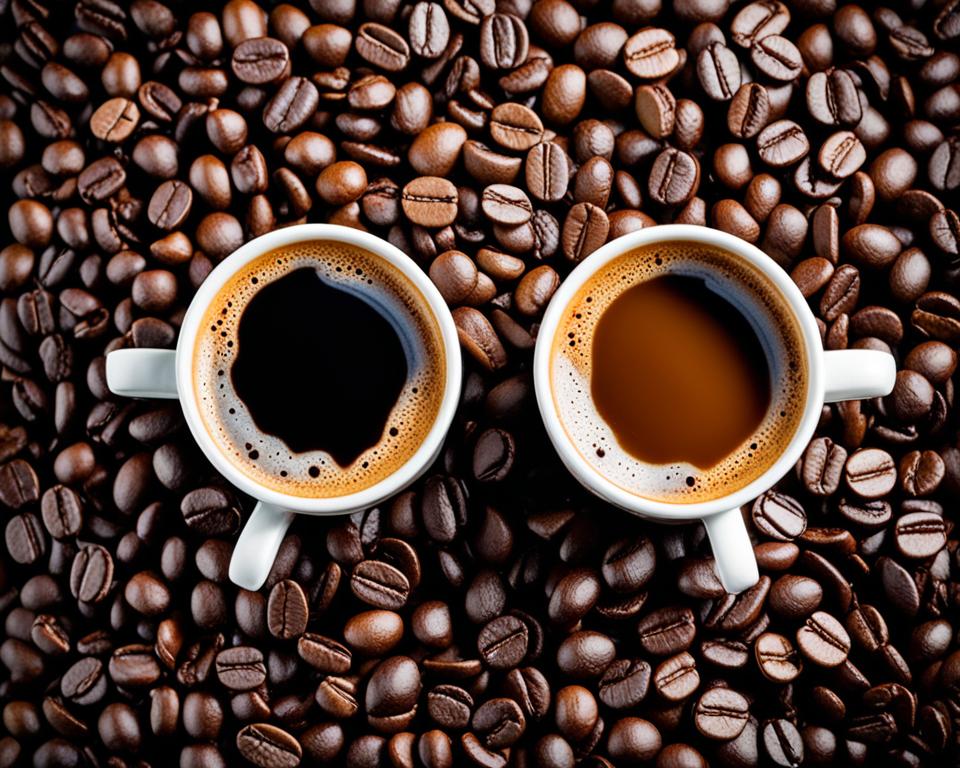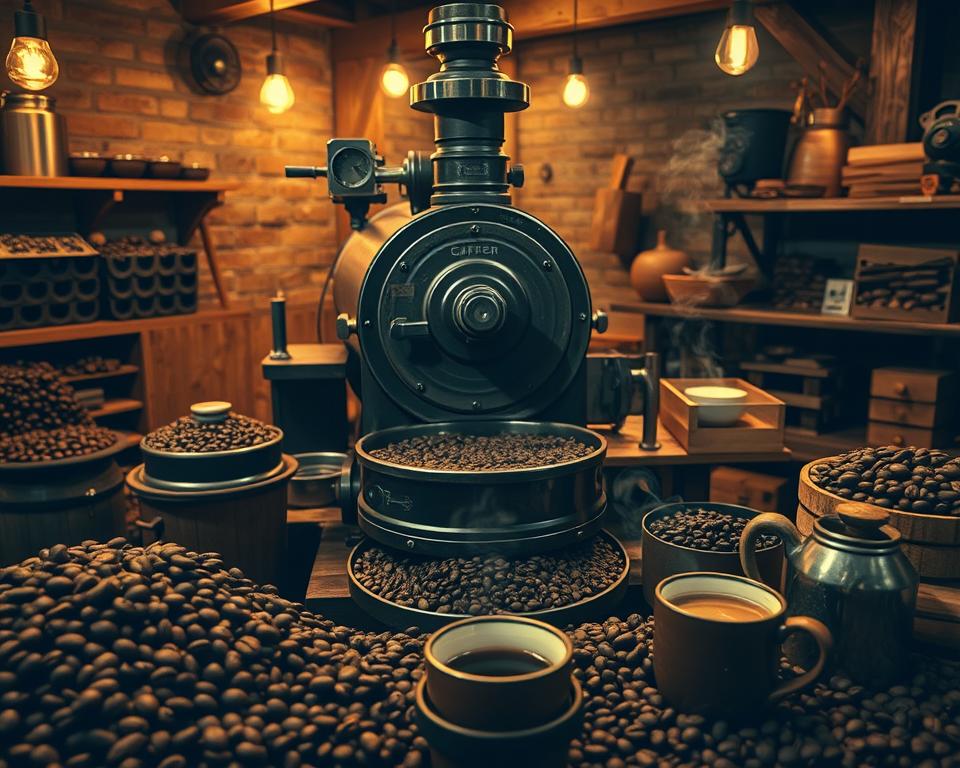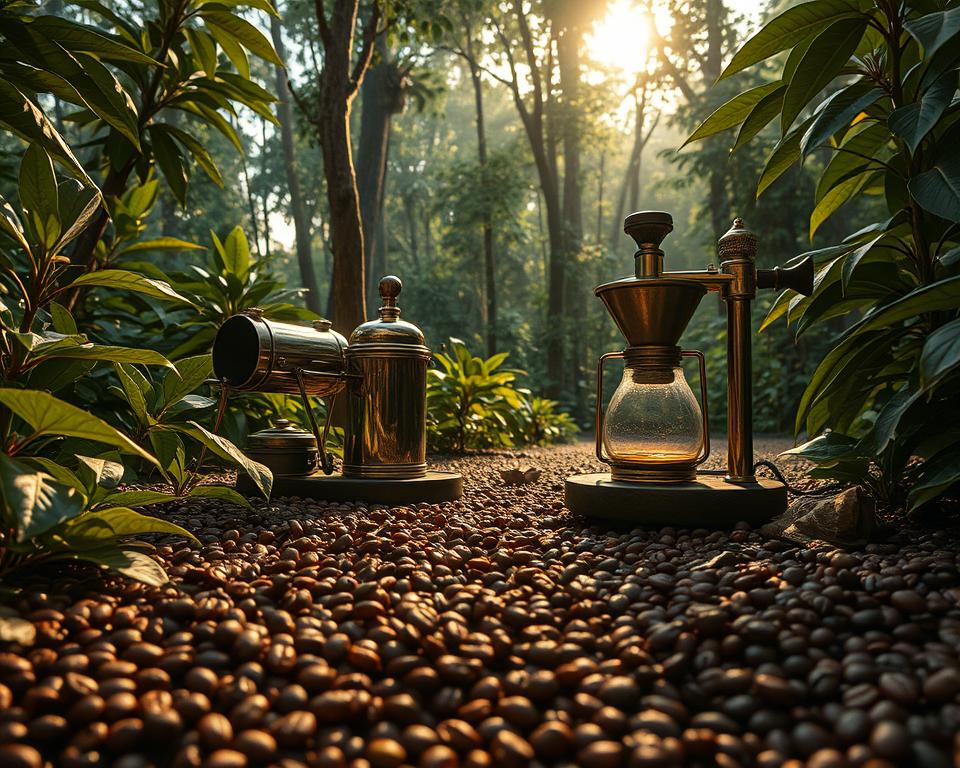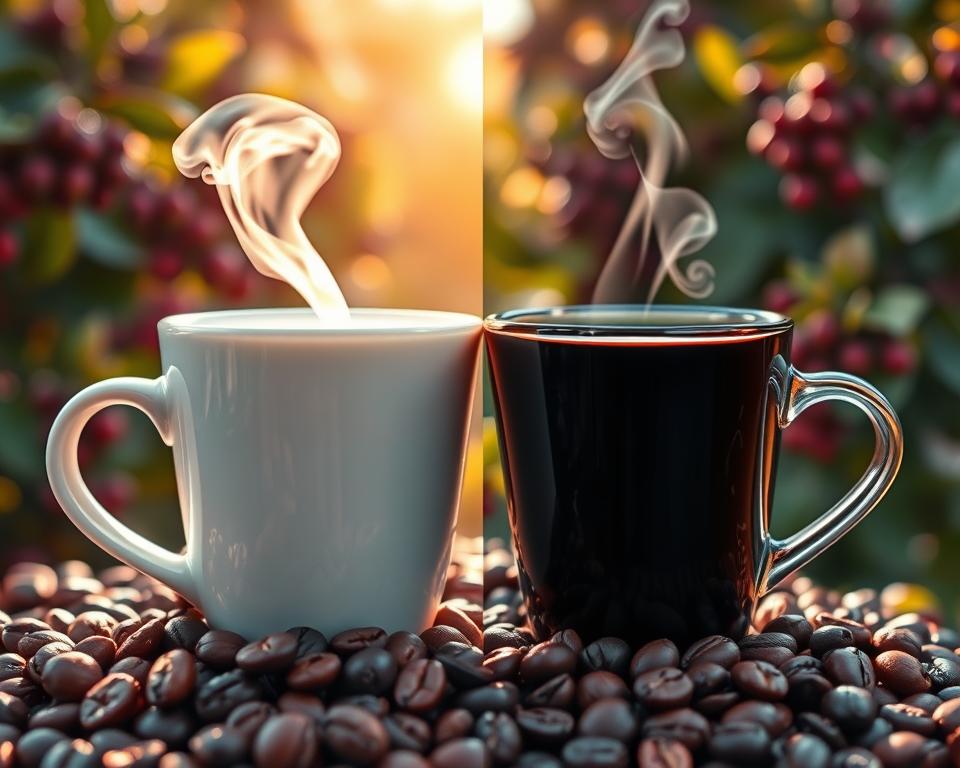Did you know that, despite popular belief, light roast coffee often has slightly more caffeine than dark roast? The world of coffee roasts is full of surprises, isn’t it?
As coffee enthusiasts, we’re often faced with the big choice: dark roast or light roast? Each has its own unique charm, and yet, common perceptions and myths can make this decision daunting.
Whether you’re curious about caffeine content in coffee or simply trying to understand different coffee roast levels and coffee flavour profiles, you’ve come to the right place.
In this read, we’ll sift through the differences between dark and light roast coffees. By the end, you’ll have a clearer picture of roast intensity, taste, caffeine levels, and brewing methods suitable for each type.
So, grab your favourite brew, sit back, and let’s embark on this flavorful journey together!
Introduction to Coffee Roasts
Ever wondered how green beans transform into the aromatic coffee you love? It all begins with the coffee roasting process. This remarkable journey turns raw, green coffee beans into diverse, richly coloured types of coffee roasts. Each stage of roasting contributes to the final flavour of your brew.
When roasting, beans undergo significant changes. Green beans are subjected to heat, causing chemical reactions that develop their colour and taste.
This coffee bean roasting is a fascinating blend of art and science, producing a spectrum of roasts ranging from light to dark.
During the coffee roasting process, beans slowly change from their natural green colour to lighter shades, eventually reaching a deep, dark brown. These stages affect the acidity, sweetness, and overall flavour profile of the coffee.
Light roasts retain more of the bean’s original flavours, while dark roasts develop bolder, sometimes smoky notes.
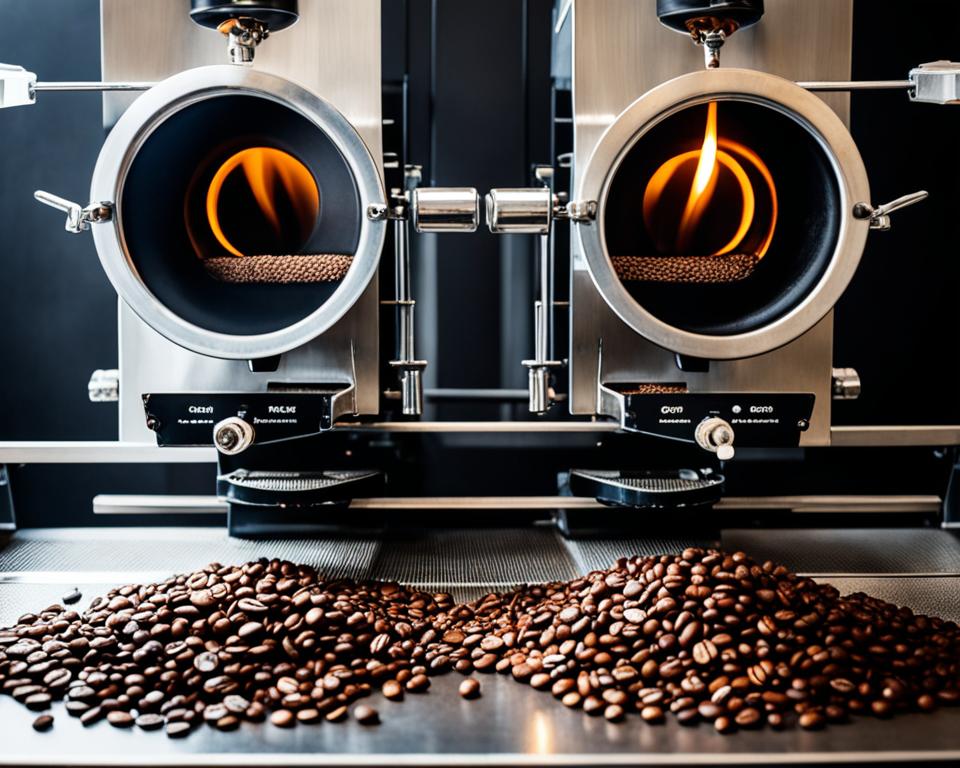
Erms like “light,” “medium,” and “dark” roasts are commonly used to describe types of coffee roasts. Light roasts are often called cinnamon or New England roasts; medium roasts might be termed American or city roasts; and dark roasts can be referred to as full city, French, or Italian roasts.
Understanding these terminologies helps coffee enthusiasts choose their preferred flavour and strength.
So next time you sip your coffee, think about the coffee roasting process it went through. Whether you prefer a light, bright cup or a rich, bold one, these types of coffee roasts offer a rich array of flavours and experiences.
The magic lies in transforming simple green beans into the delightful beverage we all cherish.
Flavour Profiles
When we talk about the flavour profiles of dark and light roasts, it’s like describing two different worlds of taste. Each roast offers a unique experience for your coffee palate, and it’s fascinating to explore what each has to offer.
What to Expect from Dark Roast
Dark roast coffee characteristics are often described as bold and rich. You’ll find flavours like chocolate, caramel, and sometimes even a hint of smokiness.
These beans usually have an oily surface, which adds to their robust flavor. If you love a full-bodied, intense cup, dark roasts won’t disappoint.
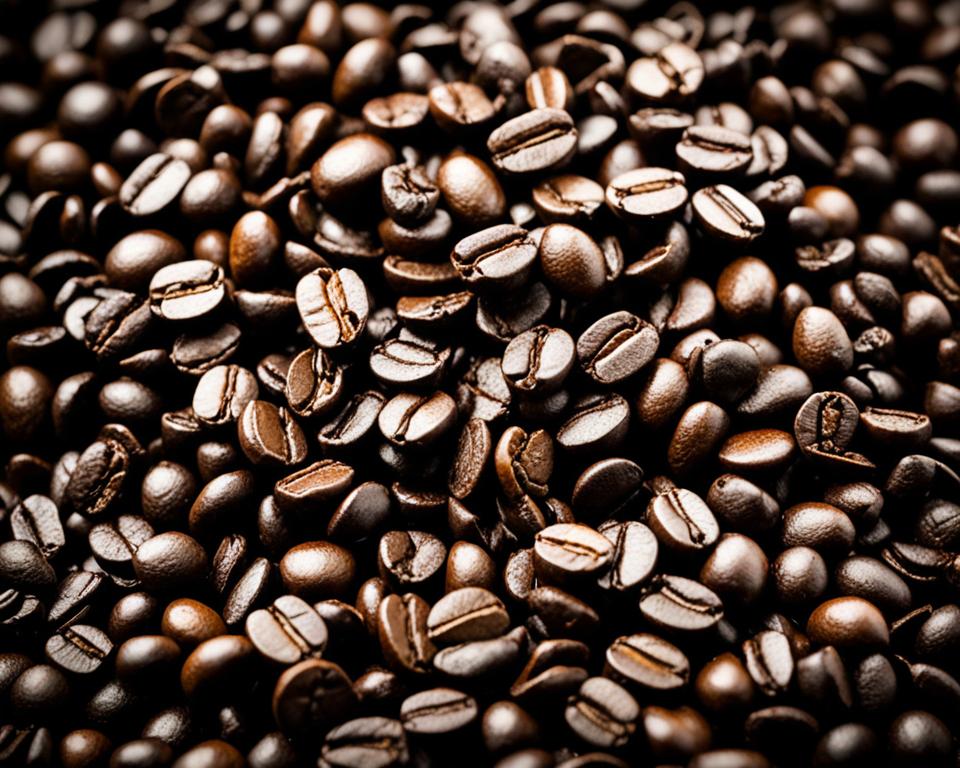
Dark roasts are popular for their low acidity and smooth finish. They create a comforting and satisfying brew, perfect for those who prefer strong coffee.
The dark roast coffee characteristics provide a taste that many find irresistible in their daily coffee routine.
What to Expect from a Light Roast
On the flip side, the light roast coffee taste is bright and lively, often highlighting the original flavours of the bean itself. If you enjoy noticing the subtle differences between coffee origins, light roasts are for you.
They offer a crisp, more acidic profile that can remind you of fruits or floral notes.
Light roasts are known for their tea-like finish, making them smoother and sometimes easier to drink without added milk or sugar. This roast is perfect if you appreciate a more delicate, nuanced flavour.
Exploring the light roast coffee taste can be a delightful journey for your coffee palate, offering a fresh and vibrant experience.
Caffeine Content
A common question among coffee lovers is whether dark roasts or light roasts have more caffeine. Let me break it down for you and clear up some misconceptions about coffee caffeine levels.
Caffeine in Dark Roast
Contrary to popular belief, dark-roasted coffee doesn’t necessarily pack more of a caffeine punch. While its robust flavour might suggest a stronger kick, the roasting process actually breaks down caffeine molecules.
This means dark roast caffeine levels are slightly lower compared to lighter roasts, but not by a drastic amount. So, if you need a caffeine boost, the darker roast isn’t always the best bet.
Caffeine in Light Roast
Light roasts often surprise people! Even though their flavour is milder, their caffeine content is often a bit higher because the beans are less exposed to heat.
When comparing dark vs. light roast caffeine, the difference isn’t huge, but it’s enough to notice. So for those who crave a caffeine kick, light roasts might just be what they need.
In essence, the roast caffeine comparison shows that both dark and light roasts have their strong points. But knowing how each roast affects caffeine levels can help you choose the right one for your daily grind.
Brewing Methods
When considering the best way to brew coffee, it’s crucial to account for the specific roast you’re working with. With diverse coffee brewing techniques, you can highlight the unique attributes of each roast, whether it’s dark or light.
The most suitable coffee roasts for brewing methods such as the French press and espresso machines are usually darker roasts. The rich, bold flavours of dark roasts are complemented by the immersion process in a French press.
Additionally, espresso machines extract the intense, robust notes that dark roasts boast.
On the flip side, the pour-over method shines with light roasts. It allows the subtle, tea-like flavours and natural acidity to come through. By experimenting with different coffee brewing techniques, you’ll find the best way to brew coffee that matches your taste.
For dark roasts, use medium-coarse grinds and steep for about four minutes with a French press. The process sets the stage for a thicker, more luxurious mouthfeel. Light roasts, however, should be ground medium-fine and brewed using a pour-over method for optimal clarity and brightness.
With these suggestions, you can enhance your coffee experience by selecting the most suitable coffee roasts for brewing methods that complement the unique characteristics of dark and light roasts.
Does the Roast Level of Coffee Affect Its Caffeine Content?
When considering how much caffeine is in coffee, roast level plays a surprising role. Darker roasts often lose some caffeine during the roasting process, while lighter roasts retain more. However, the difference is minimal, with the coffee type and brewing method having a more significant impact on caffeine content.
Conclusion
As we’ve journeyed through the world of coffee roasts, we’ve unravelled the complexities and unique aspects of both dark and light roasts. From their distinct flavour profiles and caffeine content to suitable brewing methods, choosing a coffee roast that satisfies your taste buds can be an exciting adventure.
Understanding these differences helps you make informed choices that enrich your daily coffee ritual.
Remember, the better roast isn’t set in stone; it’s a matter of personal preference in coffee. Some mornings might call for the robust, bold flavours of a dark roast, while other days, you might crave the bright, acidic notes of a light roast.
By knowing the characteristics of each type and experimenting with different brewing techniques, you can discover what truly pleases your palate.
In the end, the summary of coffee roast differences we’ve covered encourages you to embrace your preferences and enjoy the diversity that coffee offers.
Take this newfound knowledge and dive deeper into your coffee journey. Each sip can be a delightful discovery, bringing you closer to your perfect cup.
FAQ
What are the fundamental differences between dark roast and light roast coffee?
Dark-roasted coffee tends to have a bolder, richer flavour profile with hints of chocolate or smokiness and an oily surface on the beans. Light roast coffee retains the original flavours of the bean, offering brighter, more acidic notes with a smoother, tea-like finish. The difference in roast intensity also impacts the caffeine content, with light roasts generally retaining slightly more caffeine by volume.
How does the coffee roasting process transform green beans?
During the coffee roasting process, green beans undergo significant chemical changes, including Maillard reactions and caramelization. These transformations bring out the aroma, flavour, and colour that we associate with different types of coffee roasts, ranging from light to dark. Understanding the coffee roasting process helps you appreciate how each stage influences the final product.
What are the typical flavour characteristics of dark-roasted coffee?
Dark-roasted coffee is known for its rich and bold flavour profile. You might notice deep flavours with hints of chocolate, smokiness, or even a slightly bitter edge. The beans usually appear shinier due to the oils that come to the surface during roasting. These characteristics make dark roast a favourite for those who prefer intense flavours.
What unique flavours can I expect from light-roasted coffee?
Light-roasted coffee offers a bright and acidic flavour profile, allowing the original characteristics of the bean to shine through. You might experience fruity, floral, or even tea-like notes. The lighter roasting process preserves more of the beans’ inherent flavours, offering a smoother and lighter taste experience.
Does dark-roasted coffee contain more caffeine than light-roasted coffee?
There’s a common misconception that dark-roasted coffee contains more caffeine. In reality, light-roasted coffee generally has a slightly higher caffeine content per volume. The roasting process reduces caffeine content slightly, so a light roast, which is less roasted, retains more caffeine. However, when compared by weight, the difference is minimal.
Which brewing methods are best for dark-roasted coffee?
Dark-roasted coffee pairs well with brewing methods that highlight its bold flavours, such as the French press and espresso machines. These methods allow the rich and robust notes to fully develop. Additionally, using a coarser grind and a lower brewing temperature can further enhance the smooth, chocolatey, and smoky profiles prevalent in dark roasts.
Which brewing methods are best suited for light-roasted coffee?
Light roast coffee is best suited for brewing methods like pour-over, AeroPress, or drip brewing, which accentuate its delicate and intricate flavors. These methods guide through a gradual extraction process, allowing the bright, acidic, and fruity notes to emerge. Using a finer grind and a precise water temperature can help achieve the best results with light roasts.
How can I choose between dark and light roasts based on personal preference?
Choosing between dark and light roasts ultimately comes down to personal taste preferences. If you enjoy rich, bold, and chocolatey flavours, a dark roast might be more to your liking. On the other hand, if you prefer bright, fruity, and floral notes, a light roast could be the perfect choice. Experiment with different roasts and brewing methods to discover what aligns best with your palate.

